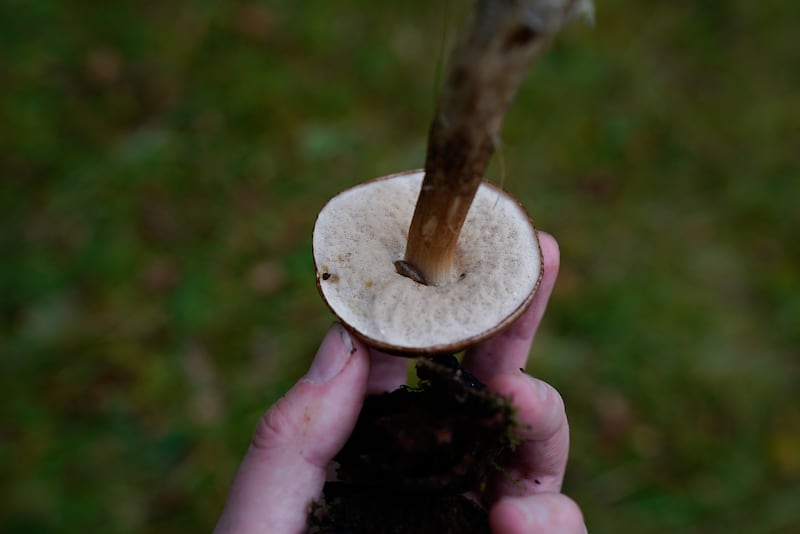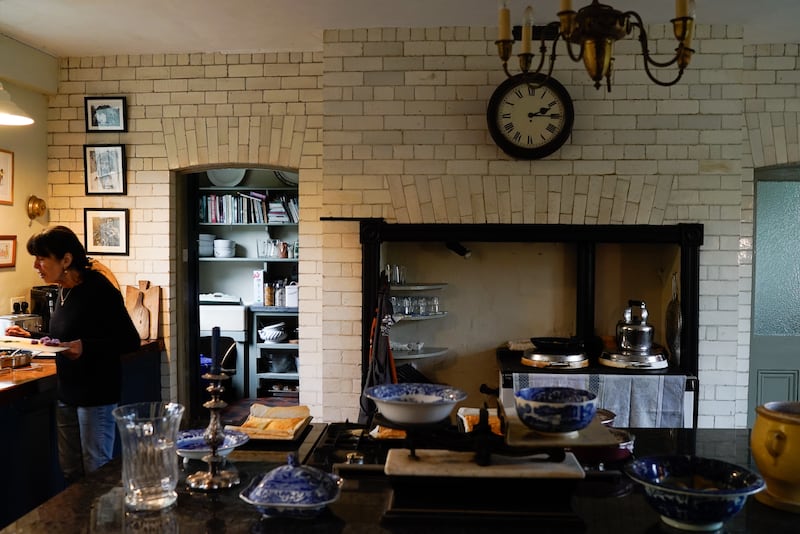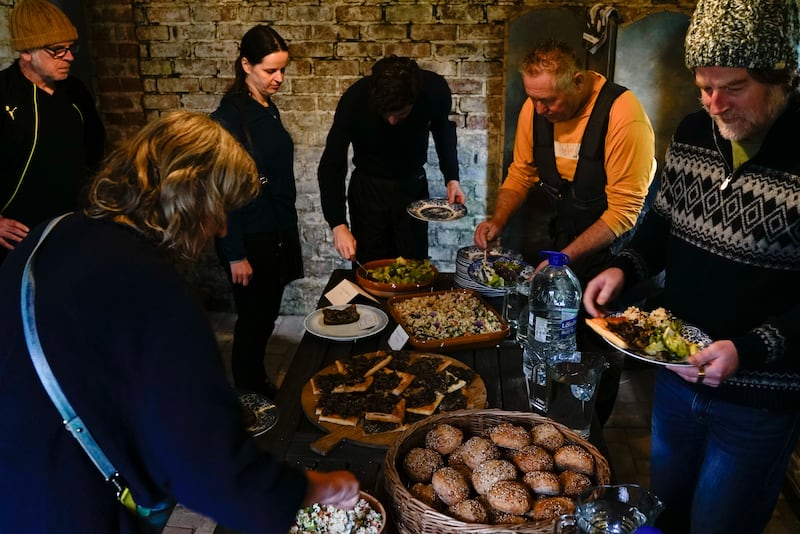A WhatsApp message drops from a family member who lives in Co Wicklow. It’s an image of two large porcini they found on their morning constitutional behind the house where they live. It triggers feelings of envy, fomo (fear of missing out). You work out the feasibility of taking a bus, train or taxi to the place where they live. You desperately want a piece of this action.
The insatiable hunger for edible wild mushrooms is usually ignited by finding one, on purpose or by accident. This happened two years ago on a visit to another relative who lives nearby in Co Carlow, when, on an afternoon walk, we discovered two large penny buns (another name for porcini) in a roadside hedgerow. Taking the meaty treasures home, we agonised for an hour or so, seeking a definitive identification of the fungus. When we were as positive as the internet could make us feel of their authenticity as edible ceps (yet another name for porcini), we thought “f**k it anyway” and chopped them up, sautéd them in butter with garlic and dispatched them via toast with some full-bodied red wine.
Was this wise? Probably not. So don’t do it. You really ought not to go picking wild mushrooms for the table unless you really know what you are doing, or unless you are with someone who really knows what they are doing.
Mushroom poisonings have spawned a niche media cottage industry, which, a bit like mushrooming itself, peaks around October in the northern hemisphere, whipping up the fear of exposure to death by rabid plants. In fairness, poisonous shrooms make for good copy. There are in the region of 30 species of mushrooms that grow in Ireland that are considered poisonous, according to the National Poisons Information Centre of Ireland (NPIC). Not all of these will cause you serious issues; some will merely make you throw up or give you a headache, but there are a handful of members of the amanita family, some of which resemble delicious edible shrooms, which can kill, such as the death cap amanita phalloides, which is thought to cause roughly one death per year in the United States. In Ireland, between 2004-2009, the NPIC was consulted on about 70 cases of suspected mushroom ingestion.
READ MORE
All of that might make mushroom hunting seem hardly worthwhile, foolhardy even, but try telling that to a smitten mycophile. You can buy “wild” mushrooms in high end food emporia, but for the most part, your chanterelles and hens of the woods will in this case have been cultivated, often by brilliant producers such as Ballyhoura in Co Cork, or sometimes imported. To the committed fungus hunter, mushrooms bought with money will always be worthless or, at least, worth less than those captured in the wild.
Mushroom-man Bill O’Dea spends a lot of his life feeding the desire for wild fungus in himself and others. One of a number of self-made experts in the field (beg your pardon, and not for the last time) O’Dea leads field trips for assorted interested parties. He has been mushroom hunting for more than three decades, since taking a course in University College Dublin back when it had a professor of mycology (the study of mushrooms).
A few Sundays back, I joined him on one of his mushroom hunts at the very beautiful Ballyteige Lodge in Co Wicklow, dropping €80 for the privilege, including lunch. It was a day when the most succinct way to understate what our climate was doing was to say that the weather wasn’t looking great. Undeterred, a rag-tag cross section of Irish life met up and set off in search of fungal edibles, assembling under the shelter of Seán McArdle’s newly renovated party hut in the garden of his historic property, where both Charles Stewart Parnell and John Redmond sucked in the sweet, musty autumnal air.
After tea and biscuits and a quasi-academic presentation by O’Dea, it was down to business as we set out, baskets-in-hand, in groups of five or six, carrying borrowed mushroom knives and our hopes and dreams. Our ever-enthusiastic host McArdle was sure we would be coming down with mushrooms. He had found “loads” just the day before. Other words of encouragement were, well, less encouraging. It had been a very dry summer, although rain the previous week had given hope that the long-awaited fruiting bodies – the visible parts of fungi we generally refer to as mushrooms – would start to spring up.
Under instructions to bring back everything, not just ones we thought were edible, heads were down in the tree litter with eyes peeled. Mushy business was not that brisk, at least not for this reporter, who perhaps doesn’t have the eyesight to penetrate the fungal camouflage. Conditions seemed perfect though. There were lots of dead trees, plenty of leaf litter, tufts of grass here and there and it was damp, but still all I could find was lichen. It was like the scene from the book The Omnivore’s Dilemma where superstar foodie mansplainer and sometime darling of the farmers’ market movement Michael Pollan describes a similar forest floor blindness when morel hunting in the woods of northern California. In Pollan’s case though, he eventually manages to “tune in” and spot a morel, after which he can’t stop seeing them. Unfortunately, that was not what happened for me, though others in the group did better and thankfully our shared basket slowly began to fill, with all kinds of fungal material.

To be honest, despite having some, albeit flimsy, mushroom-hunting credentials, I felt like an interloper, particularly in the presence of people like Archie, who comes across like a genuine woodsman, even if his day-job is as a plumber.
Archie has been interested in mushrooms since an injury to his ankle on the job put him out of action for a bit and he got into watching Ted Talks online. Here he discovered the likes of Paul Stamets, the American mycologist, mushroom entrepreneur and advocate of mycological medicine and mycoremediation, a term which refers to fungi-based methods to fix environmental damage such as chemical and oil spills. Later he saw the 2019 film Fantastic Fungi, a sort of cinematic manifesto for the then growing “mushroom movement”, directed by Louie Schwartzberg.
[ Mushroom season: On the hunt in Wicklow for the most striking fungi of them allOpens in new window ]
Archie’s grandparents picked and ate edible mushrooms, and he is keen to try to regain some of the knowledge that they possessed but has since been lost. He says he is confident enough at this stage to do some hunting by himself and has a collection of mushroom books at home to help with identification.
Archie has done a few courses and mushroom hunts including some of O’Dea’s previous outings, as well as with Courtney Tyler of Hips and Haws. Since we met, he has been out hunting parasol mushrooms in a field near where he lives in Co Kildare.
Another “mycophagic” colleague Alan has he been on many mushroom hunts with O’Dea and his wife Freda since he met them in 2004. A bit like Archie, Alan is interested in mushrooms from both a medicinal and a culinary perspective. He became aware of mushroom hunting through adverts for O’Dea’s walks placed in Mitchells wine shop in Glasthule roughly 20 years ago. BBC programmes about mushrooms and magazine articles have kept his interest alive ever since then, he says. Unlike Archie, Alan says he would never be confident enough to go out and pick them on his own, without a good guide sheet or a guide book.
Karen was less impressed with the set-up, saying she was keen to improve her mushroom foraging skills, and to learn more about where, when and how to find edible mushrooms and regain confidence in identifying ones she collected as a child. Though she liked the venue she says she thought the day was too expensive for what it was. She was expecting to be guided through the woods with plenty of practical advice, but she felt that participants were instead sent off on what was mainly a “wild goose chase”.


After lunch the contents of the mushroom baskets were laid out on a large white trestle table and roughly matched in groups for identification by O’Dea, with contributory guesswork from the assembled fungus fanciers.
There was quite a selection: honey fungus; fried chicken fungus; a few small boletes (yet another name for porcini); some amethyst deceivers – scary and beautiful looking but safe, edible and delicious; a cauliflower mushroom; and some regular field mushrooms. In addition, there were a few toxic ones including a fly agaric, and some we were not able to identify with enough certainty to risk eating. O’Dea whipped out a pan and cooked up what we had, in addition to some “bought” mushrooms he brought along, in case we didn’t manage to find any.
The mushrooms were full of flavour, seasoned by the fact we foraged them ourselves. The day filled our bellies and for some, fired the imagination, but it hardly made a dent in that bottomless desire for the pursuit of wild fungus.
Only some wild mushrooms are magic after all, but all of them seem capable of altering one’s state of consciousness.


















